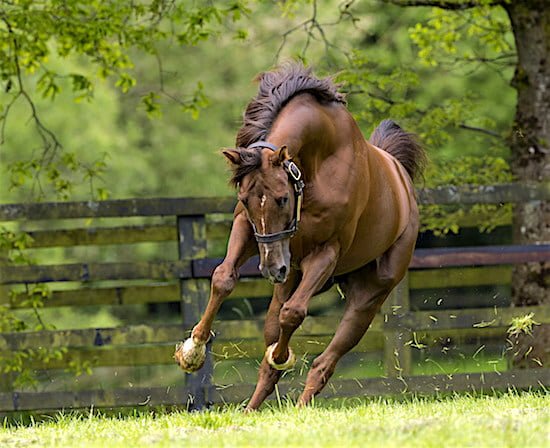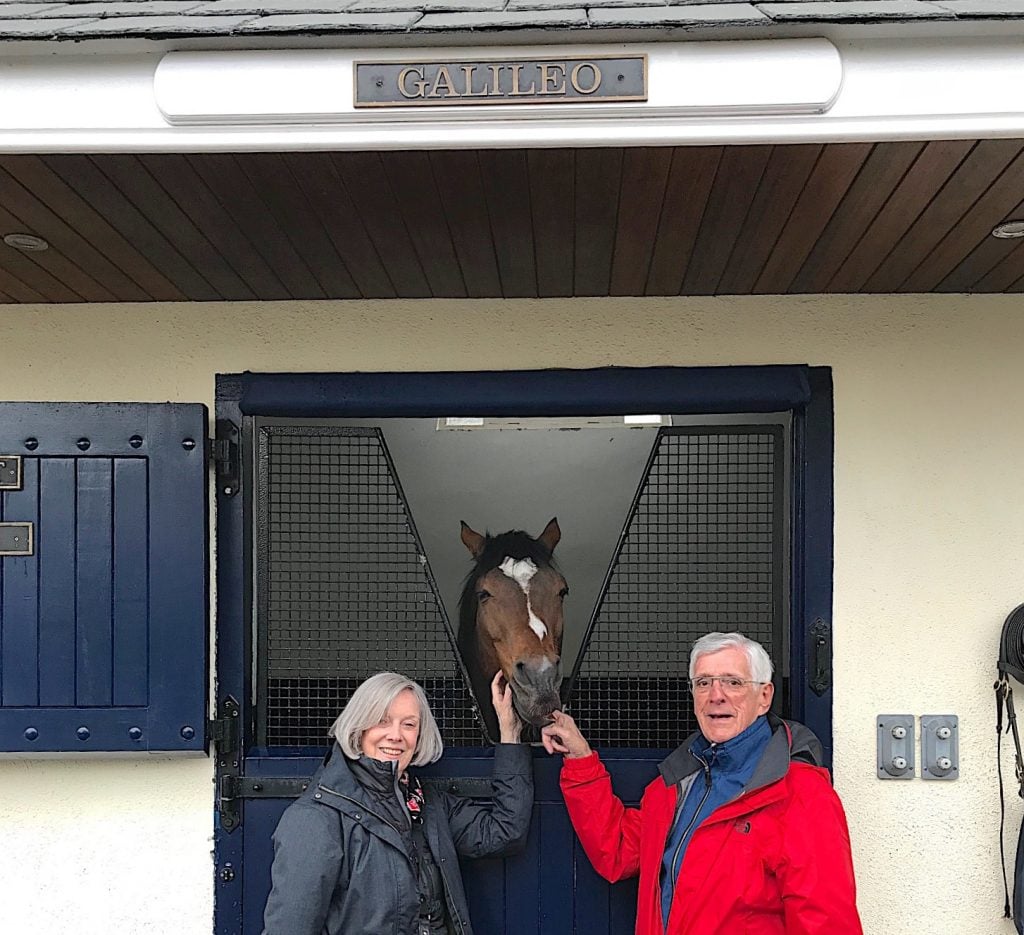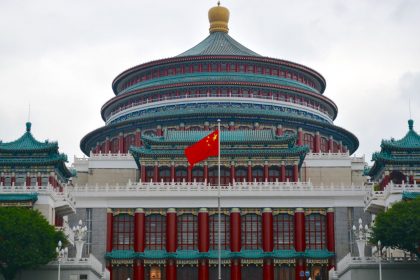Dragon Pulse had something on his mind. Something other than cantering across his two acres of grassy paddock to where my husband and I waited, hoping to meet this sleek, million-dollar stallion eye to eye. No amount of coaxing could convince the nine-year-old to ignore the flirty broodmare on her way to the cover shed. Clearly she was messaging him. And just as clearly, Dragon Pulse was not only willing, but eager, to share his DNA with her, something he was scheduled to do within the hour, and she was the third mare that day for him.
Welcome to the Irish National Stud and the silver spoon world of Ireland’s renowned race horses. Champions from around the world are either bred here or can trace their lineage back to ancestors from here. In fact, Justify has relatives at the Irish National Stud. The 2018 Belmont Stakes‘ winner and Triple Crown winner has captivated the North American horse-racing world after his victory on Saturday in New York.

Dragon Pulse is one of the most coveted stallions in the world because of the success of his offspring. His fellow stallion at the Irish National Stud, Invincible Spirit (top), earns approximately $180,000 every time he copulates with a mare. (Photos courtesy of the Irish National Stud; Dragon Pulse Photo by Bronwen Healy)
Like Ireland, The Stud has a storied past. In 1900, Colonel William Hall-Walker, heir to the Johnnie Walker distilling fortune, moved from Scotland to Ireland. He bought 400 prime acres in County Kildare, 37 miles (60 kilometres) from Dublin, with a view to breeding champion thoroughbred horses.
While stationed in India with the British Army, he developed a fascination with Eastern philosophies and astrology, including a unique vision on how horses should be raised. In particular, he believed that the sun and moon and stars played a major role in determining a horse’s ability to win a race.
In the stables, the colonel installed skylights so the horses could see the night sky. He recorded every foal’s date and time of birth, meticulously drawing up a birth chart. Bad horoscope? Bad horse. Regardless of the bloodlines, if the stars weren’t aligned to his liking, the foal was sold or, on occasion, presented to the British king.

The Irish National Stud is a picturesque and unique destination in County Kildare. (Photo courtesy of Irish National Stud)
Much to the chagrin of his trainers and of other breeders, his quirky practices paid off. Within 10 years, Hal-Walker became the most successful breeder of his time.
In 1915, he gifted the farm and all the breeding stock to the British crown, in exchange for the title, Lord Wavertree. In 1942, the newly constituted Irish government became the farm’s custodians, bringing the farm home to the people of Ireland.
Touring Ireland’s Elite Horse-Breeding Farms
Fast forward to today. The Stud encompasses 1,000 acres of prized limestone soils that, in supplying calcium to the grass, provide ideal grazing for healthy bone development.
For both locals and tourists, a visit is a horse-lover’s dream come true.
Touring here is no ordinary walk in the park. Despite security, the vibe is relaxed and family friendly. Emma, our guide, was one of 25 young men and women from around the world who were selected for the farm’s six-month, hands-on training experience, covering every aspect of horse breeding. She led us along a pristine avenue bordered by lush green paddocks, where, in addition to stallions in their prime, protective mares frolicked with their adorable, spindly legged foals and the still handsome, retired legends enjoyed lush grass all day. As stunning as the moms, pops and grandparents were, it was the babies that melted my heart, leaving me awestruck on learning that within an hour or two of being born, they were standing on their own, expecting to be fed.
Breeding season kicks off on none other than February 14 each year. For thoroughbreds, artificial insemination is illegal and the “cover” (the term used when horses mate) involves a carefully orchestrated protocol. “Until the end of summer, this place hums,” one worker at the farm told us. “We’re expecting 250 foals this spring.”
Dragon Pulse is likely to cover 100 mares this year. By percentage of winners to runners, he is currently the leading sire in Europe. With offspring performing on the race track better than he did, his 8,000-euro ($12,000) stud fee increases annually. Earning 32,000 euro ($48,000) the day we visited, he could be forgiven for a little attitude.
The National Stud’s top earner is Invincible Spirit. At 21 and showing no signs of slowing down, he commands an astronomical stud fee of 120,000 euro ($180,000). He is the great grandson of Canada’s famous Kentucky Derby winner, Northern Dancer, who is also an integral part of Justify’s pedigree.
Nestled in a quiet corner of County Tipperary, the Coolmore Stud is home to another Northern Dancer descendant, and a distant cousin to Justify. Galileo, a grandson, retired from racing in 2001 to become “the greatest stallion in the world.” The huge success enjoyed by Galileo’s progeny has jettisoned his stud fee into the strictly confidential “private” category. One can only imagine.

Writer Anna Hobbs and her husband, Byron Beeler, spend a moment with Galileo during one of his breaks at the Irish stud farm called Coolmore. (Photo supplied by Anna Hobbs)
Despite being a mature 20-year-old, the mighty Galileo is still a working horse — work that he reportedly enjoys. This year he will cover in excess of 100 mares — matings that are more shrewdly selected than the most attentively arranged marriages. When he isn’t at work, Galileo hangs out in his personal, ivy-clad stable, complete with padded walls, heat lamp, air conditioning, security cameras and a brass nameplate above the door. From his front door, he gazes out onto sumptuous lawns, tall trees and immaculately clipped hedgerows.
“Galileo has a pretty good life. And he’s loving it,” our guide told us. We were expecting that “the best sire on the planet” might have attitude, but Galileo was relaxed and friendly when we met. Not only was he up for a photo op, he was particularly partial to having his gums massaged, something my horse-loving husband was only too pleased to do.
Coolmore Stud morphed from a small breeding farm in the mid-20th century to what is generally acknowledged as today’s most influential thoroughbred race-horse breeding operation anywhere. Sitting on more than 7,000 acres of Ireland’s finest limestone pastures, this is home to equine royalty — the elite athletes and magnificent legends. Security is high and visitors are welcome only by appointment.
Ireland punches above its weight in the thoroughbred horse world, making the industry a hugely important part of the Irish economy. It’s been said that the people make being Irish great. Then there are the horses.
MORE ABOUT IRELAND’S HORSE-BREEDING FARMS
Irish National Stud
Website: irishnationalstud.ie
Admission: Adult entry costs 11.50 euro ($17.25); children’s entry is 6.50 euro ($9.75) each.
Activities: Daily guided tours last 45 minutes. The family-friendly restaurant on site is open daily from noon to 5 pm.
Coolmore
Website: coolmore.com/ireland
Admission: Visits are strictly by appointment. To inquire about a booking email info@coolmore.ie.




